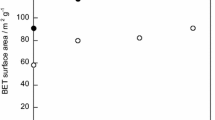Abstract
The hydrotalcite based upon manganese known as charmarite Mn4Al2(OH)12CO3·3H2O has been synthesised with different Mn/Al ratios from 4:1 to 2:1. Impurities of manganese oxide, rhodochrosite and bayerite at low concentrations were also produced during the synthesis. The thermal stability of charmarite was investigated using thermogravimetry. The manganese hydrotalcite decomposed in stages with mass loss steps at 211, 305 and 793 °C. The product of the thermal decomposition was amorphous material mixed with manganese oxide. A comparison is made with the thermal decomposition of the Mg/Al hydrotalcite. It is concluded that the synthetic charmarite is slightly less stable than hydrotalcite.




Similar content being viewed by others
References
Allmann R. Crystal structure of pyroaurite. Acta Crystallogr. 1968;24:972–7.
Ingram L, Taylor HFW. Crystal structures of sjoegrenite and pyroaurite. Mineral Mag. 1967;36:465–79.
Taylor HFW. Crystal structures of some double hydroxide minerals. Mineral Mag. 1973;39:377–89.
Rives V, editor. Layered double hydroxides: present and future. New York: Nova Science Publishers, Inc.; 2001.
Boclair JW, Braterman PS. Layered double hydroxide stability. 1. Relative stabilities of layered double hydroxides and their simple counterparts. Chem Mater. 1999;11:298–302.
Chen H-q, Zhan Z-k. Synthesis, characterization and catalysis of Cu–Mn–Al hydrotalcite like compounds, Huaxue Yanjiu Yu Yingyong 2007;19:877–81.
Fernandez JM, Barriga C, Ulibarri M-A, Labajos FM, Rives V. Preparation and thermal stability of manganese-containing hydrotalcite. J Math Chem. 1994;4:1117–21.
Sampieri A, Fetter G, Pfeiffer H, Bosch P. Carbonate phobic (Zn, Mn)-Al hydrotalcite-like compounds. Solid State Sci. 2007;9:394–403.
Chao GY, Gault RA. Quintinite-2H, quintinite-3T, charmarite-2H, charmarite-3T and caresite-3T, a new group of carbonate minerals related to the hydrotalcite—manasseite group. Can Mineral. 1997;35:1541–9.
Chen A, Xu H, Le Y, Hua W, Shen W, Gao Z. Catalyst using M/Mn/Al hydrotalcite as precursor and its preparation process. Fudan University, People Report China. Application: CN CN; 2004, p. 11.
Chen A, Xu H, Yue Y, Shen W, Hua W, Gao Z. M-Mn-Al Hydrotalcite-like Compounds as Precursors for Methyl Benzoate Hydrogenation Catalysts. Ind Eng Chem Res. 2004;43:6409–15.
Cheng H, Ding W, Lu X, Zhang Y, Ai X. Hydrotalcite type hydrocracking catalyst and its preparation method. Shanghai University, People Report China. Application: CN CN; 2008, p. 8.
Ebitani K, Motokura K, Mizugaki T, Kaneda K. Heterotrimetallic RuMnMn species on a hydrotalcite surface as highly efficient heterogeneous catalysts for liquid-phase oxidation of alcohols with molecular oxygen. Angew Chem Int Ed. 2005;44:3423–6.
Jiratova K, Cuba P, Kovanda F, Hilaire L, Pitchon V. Preparation and characterisation of activated Ni (Mn)/Mg/Al hydrotalcites for combustion catalysis. Catal Today. 2002;76:43–53.
Pacultova K, Obalova L, Kovanda F, Jiratova K. Catalytic reduction of nitrous oxide with carbon monoxide over calcined Co-Mn-Al hydrotalcite. Catal Today. 2008;137:385–9.
Chitrakar R, Tezuka S, Sonoda A, Sakane K, Ooi K, Hirotsu T. Adsorption of phosphate from seawater on calcined MgMn-layered double hydroxides. J Colloid Interface Sci. 2005;290:45–51.
Harrison DP. Sorption-enhanced hydrogen production: a review. Ind Eng Chem Res. 2008;47:6486–501.
Brown G, Van Oosterwyck-Gastuche MC. Mixed magnesium-aluminum hydroxides. II. Structure and structural chemistry of synthetic hydroxycarbonates and related minerals and compounds. Clay Miner. 1967;7:193–201.
Taylor HFW. Segregation and cation-ordering in sjogrenite and pyroaurite. Mineral Mag. 1969;37:338–42.
Taylor RM. Stabilization of color and structure in the pyroaurite-type compounds iron(II) iron(III) aluminum(III) hydroxycarbonates. Clay Miner. 1982;17:369–72.
Kloprogge JT, Wharton D, Hickey L, Frost RL. Infrared and Raman study of interlayer anions CO2–3, NO-3, SO2–4 and CIO-4 in Mg/Al-hydrotalcite. Am Mineral. 2002;87:623–9.
Frost RL, Hales MC, Martens WN. Thermogravimetric analysis of selected group (II) carbonate minerals—Implication for the geosequestration of greenhouse gases. J Therm Anal Calorim. 2009;95:999–1005.
Palmer SJ, Spratt HJ, Frost RL. Thermal decomposition of hydrotalcites with variable cationic ratios. J Therm Anal Calorim. 2009;95:123–9.
Frost RL, Locke AJ, Hales MC, Martens WN. Thermal stability of synthetic aurichalcite. Implications for making mixed metal oxides for use as catalysts. J Therm Anal Calorim. 2008;94:203–8.
Vagvoelgyi V, Daniel LM, Pinto C, Kristof J, Frost RL, Horvath E. Dynamic and controlled rate thermal analysis of attapulgite. J Therm Anal Calorim. 2008;92:589–94.
Vagvolgyi V, Frost RL, Hales M, Locke A, Kristof J, Horvath E. Controlled rate thermal analysis of hydromagnesite. J Therm Anal Calorim. 2008;92:893–7.
Vagvolgyi V, Hales M, Martens W, Kristof J, Horvath E, Frost RL. Dynamic and controlled rate thermal analysis of hydrozincite and smithsonite. J Therm Anal Calorim. 2008;92:911–6.
Pagano R. New minerals. Updates of systematic mineralogy, Rivista Mineralogica Italiana 1999;1:62–6.
Nickel EH, Wildman JE. Hydrohonessite—a new hydrated nickel-iron hydroxysulfate mineral; its relationship to honessite, carrboydite, and minerals of the pyroaurite group. Mineral Mag. 1981;44:333–7.
Bish DL, Livingstone A. The crystal chemistry and paragenesis of honessite and hydrohonessite: the sulfate analogs of reevesite. Mineral Mag. 1981;44:339–43.
Nickel EH, Clarke RM. Carrboydite, a hydrated sulfate of nickel and aluminum: a new mineral from Western Australia. Am Mineral. 1976;61:366–72.
Acknowledgements
The financial and infra-structure support of the Queensland Research and Development Centre (QRDC-RioTintoAlcan) and the Queensland University of Technology Inorganic Materials Research Program of the School of Physical and Chemical Sciences are gratefully acknowledged. One of the authors (LMG) thanks the Queensland University of Technology for a visiting student fellowship.
Author information
Authors and Affiliations
Corresponding author
Appendix
Appendix
Calculation of water content for Mn2+/Al3+ hydrotalcite
-
Proposed composition Mn6Al2(OH)16CO3·xH2O
-
Total mass of hydrotalcite analysed: 26.852 mg
-
% mass loss of water up to 264 °C: 9.67%
-
Mass of water removed up to 264 °C: 2.5966 mg
-
Molar mass of water: 18.02 g mol−1
-
Moles of water removed: 0.144095 mmol
-
Mass of dehydrated mineral: 26.852 – 2.5966 = 24.2554 mg
-
Molar mass of dehydrated mineral: 715.738 g mol−1
-
Moles of dehydrated mineral: 0.033888 mmol
Calculation of x:
-
1 mol dehydrated mineral: x mol H2O
-
0.033888 mmol dehydrated mineral: 0.144095 mmol H2O
-
x = 4.2521 − 4 mol
-
Formula: Mn6Al2(OH)16CO3·4H2O
Rights and permissions
About this article
Cite this article
Grand, LM., Palmer, S.J. & Frost, R.L. Synthesis and thermal stability of hydrotalcites containing manganese. J Therm Anal Calorim 100, 981–985 (2010). https://doi.org/10.1007/s10973-009-0402-z
Received:
Revised:
Accepted:
Published:
Issue Date:
DOI: https://doi.org/10.1007/s10973-009-0402-z




